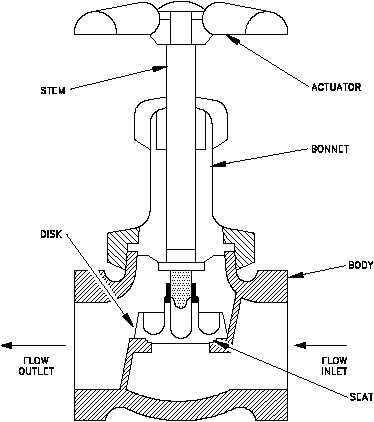TYPES OF VALVES
DOE-HDBK-1018/2-93
Valves
Butterfly check valves may be
Figure 27 Stop Check Valve
installed
horizontally
or
vertically with the vertical flow
either upward or downward.
Care should be taken to ensure
that the valve is installed so
that the entering flow comes
from the hinge post end of the
valve; otherwise, all flow will
be stopped.
Stop Check Valves
A stop check valve, illustrated
in Figure 27, is a combination
of a lift check valve and a
globe valve.
It has a stem
which, when closed, prevents
the disk from coming off the
seat and provides a tight seal
(similar to a globe valve).
When the stem is operated to
the open position, the valve
operates as a lift check. The
stem is not connected to the
disk and functions to close the
valve tightly or to limit the
travel of the valve disk in the
open direction.
Relief and Safety Valves
Relief and safety valves prevent equipment damage by relieving accidental over-pressurization
of fluid systems. The main difference between a relief valve and a safety valve is the extent of
opening at the setpoint pressure.
A relief valve, illustrated in Figure 28, gradually opens as the inlet pressure increases above the
setpoint. A relief valve opens only as necessary to relieve the over-pressure condition. A safety
valve, illustrated in Figure 29, rapidly pops fully open as soon as the pressure setting is reached.
A safety valve will stay fully open until the pressure drops below a reset pressure. The reset
pressure is lower than the actuating pressure setpoint. The difference between the actuating
pressure setpoint and the pressure at which the safety valve resets is called blowdown.
Blowdown is expressed as a percentage of the actuating pressure setpoint.
ME-04
Rev.0
Page 40

